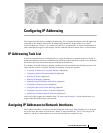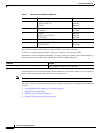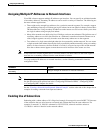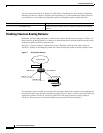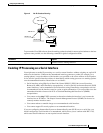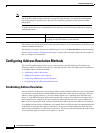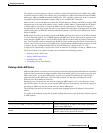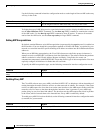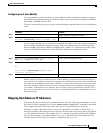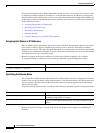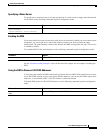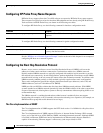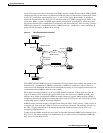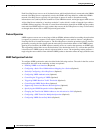
Configuring IP Addressing
Configuring Address Resolution Methods
IPC-13
Cisco IOS IP Configuration Guide
The software uses three forms of address resolution: Address Resolution Protocol (ARP), proxy ARP,
and Probe (similar to ARP). The software also uses the Reverse Address Resolution Protocol (RARP).
ARP, proxy ARP, and RARP are defined in RFCs 826, 1027, and 903, respectively. Probe is a protocol
developed by the Hewlett-Packard Company (HP) for use on IEEE-802.3 networks.
ARP is used to associate IP addresses with media or MAC addresses. Taking an IP address as input, ARP
determines the associated media address. Once a media or MAC address is determined, the IP address
or media address association is stored in an ARP cache for rapid retrieval. Then the IP datagram is
encapsulated in a link-layer frame and sent over the network. Encapsulation of IP datagrams and ARP
requests and replies on IEEE 802 networks other than Ethernet is specified by the Subnetwork Access
Protocol (SNAP).
RARP works the same way as ARP, except that the RARP request packet requests an IP address instead
of a local data-link address. Use of RARP requires a RARP server on the same network segment as the
router interface. RARP often is used by diskless nodes that do not know their IP addresses when they
boot. The Cisco IOS software attempts to use RARP if it does not know the IP address of an interface at
startup. Also, Cisco routers can act as RARP servers by responding to RARP requests that they are able
to answer. See the “Configure Additional File Transfer Functions” chapter in the Cisco IOS
Configuration Fundamentals Configuration Guide to learn how to configure a router as a RARP server.
The tasks required to set address resolution are contained in the following sections:
• Defining a Static ARP Cache
• Setting ARP Encapsulations
• Enabling Proxy ARP
• Configuring Local-Area Mobility
Defining a Static ARP Cache
ARP and other address resolution protocols provide a dynamic mapping between IP addresses and media
addresses. Because most hosts support dynamic address resolution, generally you need not specify static
ARP cache entries. If you must define them, you can do so globally. Performing this task installs a
permanent entry in the ARP cache. The Cisco IOS software uses this entry to translate 32-bit IP
addresses into 48-bit hardware addresses.
Optionally, you can specify that the software respond to ARP requests as if it were the owner of the
specified IP address. In case you do not want the ARP entries to be permanent, you have the option of
specifying an ARP entry timeout period when you define ARP entries.
The following two tables list the tasks to provide static mapping between IP addresses and a media
address.
Use either of the following commands in global configuration mode to specify that the software respond
to ARP requests:
Command Purpose
Router(config)# arp ip-address hardware-address type
Globally associates an IP address with a media (hardware)
address in the ARP cache.
Router(config)# arp ip-address hardware-address type
alias
Specifies that the software responds to ARP requests as if it
were the owner of the specified IP address.





